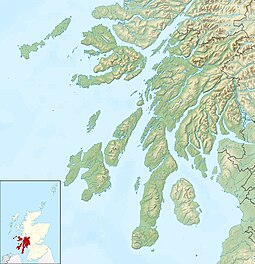
Back Ii ANG إيونا Arabic Iona AST Ayona Azerbaijani Ì Chaluim Chille Breton Iona Catalan Iona (pulo sa Hiniusang Gingharian) CEB Iona Czech Iona Welsh Iona Danish
| Scottish Gaelic name | Ì Chaluim Chille |
|---|---|
| Pronunciation | [ˈiː ˈxal̪ˠɪm ˈçiʎə] ⓘ |
 The Abbey as seen from the sea | |
| Location | |
Iona shown within Argyll and Bute | |
| OS grid reference | NM275245 |
| Coordinates | 56°19′48″N 06°24′36″W / 56.33000°N 6.41000°W |
| Physical geography | |
| Island group | Mull |
| Area | 877 ha (3+3⁄8 sq mi) |
| Area rank | 56 [1] |
| Highest elevation | Dùn Ì, 101 m (331 ft) |
| Administration | |
| Council area | Argyll and Bute |
| Country | Scotland |
| Sovereign state | United Kingdom |
| Demographics | |
| Population | 177[2] |
| Population rank | 35 [1] |
| Largest settlement | Baile Mór |
| References | [3][4][5] |
Iona (/aɪˈoʊnə/; Scottish Gaelic: Ì Chaluim Chille [ˈiː ˈxal̪ˠɪm ˈçiʎə] ⓘ, sometimes simply Ì) is an island in the Inner Hebrides, off the Ross of Mull on the western coast of Scotland. It is mainly known for Iona Abbey, though there are other buildings on the island. Iona Abbey was a centre of Gaelic monasticism for three centuries[3] and is today known for its relative tranquility and natural environment.[6] It is a tourist destination and a place for spiritual retreats. Its modern Scottish Gaelic name means "Iona of (Saint) Columba" (formerly anglicised as "Icolmkill").
In 2019, Iona's estimated population was 120.[7] In March 1980, the Hugh Fraser Foundation donated much of the main island (and its off-lying islands) to the current owner, the National Trust for Scotland. The abbey and some church buildings are owned by the Iona Cathedral Trust.[8]
One publication, describing the religious significance of the island, says that the island is "known as the birthplace of Celtic Christianity in Scotland,” and notes that “St Columba came here in the year 563 to establish the Abbey, which still stands".[9]
- ^ a b Area and population ranks: there are c. 300 islands over 20 ha in extent and 93 permanently inhabited islands were listed in the 2011 census.
- ^ National Records of Scotland (15 August 2013). "Appendix 2: Population and households on Scotland's Inhabited Islands" (PDF). Statistical Bulletin: 2011 Census: First Results on Population and Household Estimates for Scotland Release 1C (Part Two) (PDF) (Report). SG/2013/126. Retrieved 14 August 2020.
- ^ a b Haswell-Smith (2004) pp. 80-84
- ^ Ordnance Survey. OS Maps Online (Map). 1:25,000. Leisure.
- ^ Anderson, Joseph (Ed.) (1893) Orkneyinga Saga. Translated by Jón A. Hjaltalin & Gilbert Goudie. Edinburgh. James Thin and Mercat Press (1990 reprint). ISBN 0-901824-25-9
- ^ Murray (1966) p 81
- ^ "Isle of Iona".
- ^ "Isle of Iona".
- ^ "The perfect way to go island hopping in the Hebrides".

